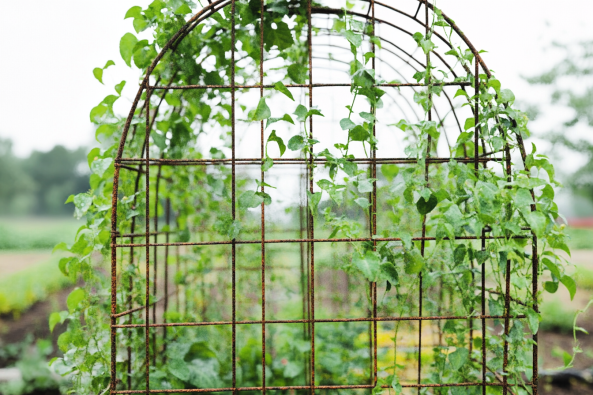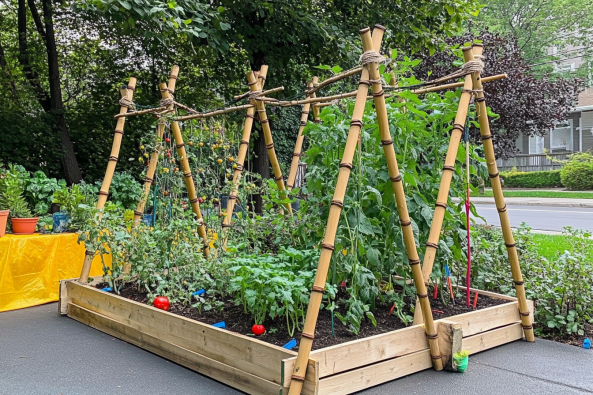Why Build a DIY Tomato Trellis?
A DIY tomato trellis is a cost-effective and sturdy solution for supporting your tomato plants. Unlike store-bought cages, a homemade trellis provides better stability, enhances plant health, and maximizes yield.
Benefits of Using a Trellis for Tomato Plants
- Improves Airflow: Reduces disease by preventing moisture buildup.
- Enhances Sun Exposure: Ensures even ripening of tomatoes.
- Supports Heavy Fruit: Prevents tomatoes from sagging or breaking branches.
Cost Savings Compared to Store-Bought Cages
- A DIY trellis costs a fraction of commercial cages.
- Uses budget-friendly materials like reclaimed wood, bamboo, or PVC.
Types of Tomato Trellis Designs

1. Stake Weave Trellis (Florida Weave Method)
- Best for: Determinate tomatoes.
- Materials Needed: Wooden stakes, garden twine.
- Setup Process:
- Place stakes every 2-3 feet along the row.
- Weave twine around the stakes, securing tomato plants between the lines.
- Continue weaving every 6-8 inches as plants grow.
2. A-Frame Wooden Tomato Trellis
- Best for: Maximizing vertical space.
- Materials Needed: Wooden planks, screws, hinges.
- Building Steps:
- Cut two equal wooden planks for the sides.
- Attach a crossbeam at the top using hinges.
- Secure additional slats for climbing support.
3. DIY PVC Pipe Tomato Trellis
- Best for: Lightweight and budget-friendly gardening.
- Materials Needed: PVC pipes, connectors, zip ties.
- How to Assemble:
- Cut PVC pipes to desired height.
- Connect using elbow joints for a sturdy frame.
- Secure netting or garden twine for plant support.
4. String and Wire Trellis
- Best for: Indeterminate tomato varieties.
- Setup Guide:
- Install two tall stakes or posts.
- Attach strong wire between them.
- Tie string from the wire down to each plant.
Materials Needed for a Sturdy DIY Tomato Trellis
Budget-Friendly Options
- Reclaimed Wood: Cost-effective and eco-friendly.
- PVC Pipes: Lightweight and easy to assemble.
- Bamboo Stakes: Naturally strong and durable.
Essential Tools
- Saw (for cutting wood or PVC)
- Drill & Screws (for wooden trellises)
- Zip Ties & Garden Twine (for securing plants)
Choosing Weather-Resistant Materials
- Use treated wood to prevent rot.
- Apply outdoor sealant to extend durability.
Step-by-Step Guide to Building a Simple Wooden Tomato Trellis

1 – Measure and Cut the Wood
- Best Dimensions:
- 6-7 feet tall for indeterminate tomatoes.
- 3-4 feet tall for determinate varieties.
- Adjusting for Garden Size:
- Wider trellises accommodate multiple plants.
2 – Assemble the Trellis Frame
- Screws vs. Nails:
- Screws provide better durability and flexibility.
- Best Wood Types:
- Cedar and redwood are rot-resistant.
3 – Secure the Cross Supports
- Spacing Recommendations:
- Place cross supports 12-18 inches apart.
- Alternative Materials:
- Use wire mesh instead of wooden slats.
4 – Install the Trellis in Your Garden
- Anchoring Methods:
- Dig holes 12 inches deep and set trellis legs.
- Secure with concrete for extra stability.
5 – Training Tomato Plants to Climb the Trellis
- Tying Techniques:
- Use soft garden ties to avoid stem damage.
- Pruning for Better Growth:
- Remove lower leaves to improve airflow.
Maintenance Tips for a Long-Lasting Trellis
- Weatherproofing: Apply sealant or paint to protect wood.
- Seasonal Checks: Inspect joints and supports before planting season.
- Repairing Damage: Replace broken stakes or worn-out ties.
Common Mistakes to Avoid When Building a Tomato Trellis
- Using Weak or Untreated Wood: Leads to rotting and breakage.
- Not Securing the Trellis Deep Enough: Causes instability in strong winds.
- Overcrowding Tomato Plants: Reduces airflow, leading to disease.
Budget-Friendly Alternatives to Traditional Tomato Trellises
- Upcycling Materials:
- Old ladders, fences, or wooden pallets.
- Repurposing Natural Elements:
- Bamboo sticks and metal rods for sturdy support.
Conclusion: Grow Healthier Tomatoes with a DIY Trellis
A well-built DIY tomato trellis enhances plant growth, saves money, and maximizes yield. Whether you choose a wooden A-frame, PVC structure, or string trellis, your tomato plants will benefit from strong and stable support.
Related Posts You May Like
For additional inspiration, check out this DIY wooden tomato trellis guide.

